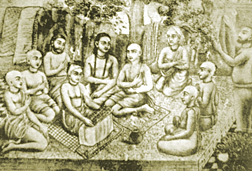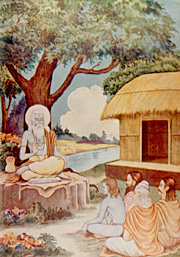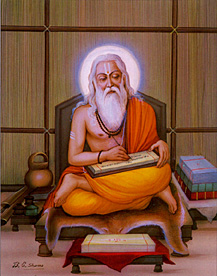
 OBJECTION: In your arguments you have mostly quoted purana-vakya (quotes from Puranic texts) to substantiate your points. However, this is unacceptable. The Vedas are eternal as they emanate from the Lord Himself (apaurusaya), whereas the Puranas and smrti-sastras, although they give knowledge about God, are authored by men. They are auxiliary to the Vedas and hence their statements should be considered as secondary when compared to the statements made in the Vedas. Therefore, in order to validate your claims, you must give quotes from sruti only.
OBJECTION: In your arguments you have mostly quoted purana-vakya (quotes from Puranic texts) to substantiate your points. However, this is unacceptable. The Vedas are eternal as they emanate from the Lord Himself (apaurusaya), whereas the Puranas and smrti-sastras, although they give knowledge about God, are authored by men. They are auxiliary to the Vedas and hence their statements should be considered as secondary when compared to the statements made in the Vedas. Therefore, in order to validate your claims, you must give quotes from sruti only.
REFUTATION: That the Vedas are eternal and apauruseya is a fact that all sampradayas, including the school of Sankara, unanimously agree with. They constitute the means of receiving knowledge about the Absolute Truth. However, there are certain factors that make it practically impossible to study the Vedas in this age:
 After Srila Vyasadeva divided the Vedas into four books (Rg, Yajur, Sama and Atharva), his disciples further divided them into 1,130 divisions. This is stated in the Kurma Purana (52.19-20):
After Srila Vyasadeva divided the Vedas into four books (Rg, Yajur, Sama and Atharva), his disciples further divided them into 1,130 divisions. This is stated in the Kurma Purana (52.19-20):
eka-vimsati-bhedena rg-vedam krtavan pura
sakhanam satenaiva yajur-vedam athakarot
sama-vedam sahasrena sakhanam prabibheda sah
atharvanam atho vedam bibedha navakena tu
‘Previously the Rg Veda was divided into 21 sections, the Yajur Veda into 100 sections, the Sama Veda into 1,000 sections and the Atharva Veda into 9 divisions.’
Each division has 4 minor divisions, namely the Samhitas, Brahmanas, Aranyakas and Upanisads. Thus altogether the 4 Vedas contain 1,130 Samhitas, 1,130 Brahmanas, 1,130 Aranyakas, and 1,130 Upanisads. This makes a total of 4,520 divisions.
At present, most of these texts have disappeared due to the influence of time. We can only find 11 Samhitas, 18 Brahmanas, 7 Aranyakas and 220 Upanisads which constitutes a mere 6% of the entire Vedic canon!
- Even if the Vedas were complete in there entirety, in order to understand them one must first study the Vedangas which includes Siksa (the science of phonetics), Vyakarana (grammatical rules), Kalpa (ritualistic rules), Nirukta (obscure word meanings), Chanda (Metres for chanting Vedic hymns), and Jyotisa (astrology and astronomy).
- Since the language of the Vedas is enshrouded in mysterious meanings, one must also be willing to sacrifice years of study in order to learn Vaidika (classical) Sanskrit. This entails primarily learning the basic grammar (which generally takes 12 years or so) and then memorising extra vocabulary in order to decipher the mystical language of the Vedas. 1
Apart from that, it is practically impossible for those born in the age of Kali (who are generally ‘mandah sumanda-matayo’) to memorise even the slightest thing. What to speak of the entire Vedas or even the 6% that still survives today! At present, amongst the brahmana communities in India, it is generally observed that vedadhyayana simply consists of memorising the text of one of the four Vedas ‘parrot-fashion’, but as we can see from above, there is much more to it than that. Therefore, we may conclude that although the Vedas are perfect sabda-pramana, it is impractical to become thoroughly conversant with the Vedas in this day and age in order to understand the Supreme. Hence the solution lies in the Puranas and the Itihasas. This is explained in the following verse -
bharata-vyapadesena hyamnayarthah pradarsitah
vedah pratisthah sarve sarve purane natra samsayah
"On the pretext of writing the Mahabharata, Vyasa explained the meaning of the Vedas. Certainly all the topics of the Vedas have been established in the Puranas." (Visnu Purana)
Furthermore, it is explained in the Mahabharata (Adi Parva 1.267) and Manu Samhita –
itihasa puranabhyam vedam samupabrmhayet
" One must complement one’s study of the Vedas with the Itihasas and the Puranas."
In the Prabhasa-khanda of the Skanda Purana (5.3.121-124) it is said –
veda-van niscalam manye puranartham dvijottamah
vedah pratisthitah sarve purane natra samsayah
bibhety-alpa-srutad vedo mam ayam calayisyati
itihasa-puranais tu niscalo’yam krtah purah
yan na drstam hi vedesu tad drstam smrtisu dvijah
ubhayor yan na drstam hi tat puranah pragiyate
yo veda caturo vedan sangopanisado dvijah
puranam naiva janati na ca sa syad vicaksana
" O best of the brahmanas, the meaning of the Puranas is unchanging just like that of the Vedas. The Vedas are all sheltered within the Puranas without a doubt. The Veda has a fear that unqualified people will read her and then distort her meaning. Thus, the significance of the Veda was fixed in the Puranas and Itihasas. That which is not found in the Vedas is found in the Smrti. That which is not found in the Smrti is to be found in the Puranas. Those who know even the Vedas and Upanisads are not learned if they do not know the Puranas."
 The reason they are called ‘Puranas’ is because they make the Vedas complete (puranat puranam iti canyatra). This is not to suggest that the Vedas are incomplete. It simply means that the Puranas are explanatory supplements which aid one to understand the concise and ambiguous passages in the Vedas. If the Puranas complete the Vedas, it is only logical that they must be Vedic in nature.
The reason they are called ‘Puranas’ is because they make the Vedas complete (puranat puranam iti canyatra). This is not to suggest that the Vedas are incomplete. It simply means that the Puranas are explanatory supplements which aid one to understand the concise and ambiguous passages in the Vedas. If the Puranas complete the Vedas, it is only logical that they must be Vedic in nature.
Our Tattvavadi friends have stated that Puranic evidence is secondary to those statements of the sruti because they are composed by mortals. Generally it is correct to state that the sruti is primary and the smrti secondary in that it (sruti) seeks to elaborate on the meaning of the smrti. However, under the circumstances, the puranas and itihasas are now to be considered primary evidence. As regards the mortal composition of the puranas and Itihasas, 2 we beg to differ with this view, on the basis of the following references in the sruti-sastras
rcah samani chandamsi puranam yajusa saha
ucchistaj-jajnire sarve divi deva divi-sritah
"The Rg, Sama, Yajur and Atharva became manifest from the Lord, along with the Puranas and all the Devas residing in the heavens." (Atharva Veda 11.7.24)
sa brhatim disam anu vyacalat tam itihasas ca puranam ca gathas ca itihasasya ca sa vai puranasya ca gathanam ca narasamsinam ca priyam dhama bhavati ya evam veda
"He approached the brhati meter, and thus the Itihasas, Puranas, Gathas and Narasamsis became favorable to him. One who knows this verily becomes the beloved abode of the Itihasas, Puranas, Gathas and Narasamsis." (Atharva Veda 15.6.10–12)
evam ime sarva veda nirmitah sa-kalpah sa-rahasyah sa-brahmanah sopanisatkah setihasah sanvakhyatah sa-puranan
"In this way, all the Vedas were manifested along with the Kalpas, Rahasyas, Brahmanas, Upanisads, Itihasas, Anvakhyatas and the Puranas." (Gopatha Brahmana, purva 2.10)
nama va rg-vedo yajur-vedah sama-veda atharvanas caturtha itihasa-puranah pancamo vedanam vedah
"Indeed, Rg, Yajur, Sama and Atharva are the names of the four Vedas. The Itihasas and Puranas are the fifth Veda." (Kauthumiya Chandogya Upanisad 7.1.4)
asya mahato bhutasya nihsvasitam etad yad rg-vedo yajur-vedah sama
vedo’tharvangirasa itihasah puranam ityadina
"O Maitreya, the Rg, Yajur, Sama and Atharva Vedas as well as the Itihasas and the Puranas all manifest from the breathing of the Lord." (Madhyandina-sruti, Brhad-aranyaka Upanisad 2.4.10)
From these above sruti statements it is clear that the puranas are part of the Vedas and originate from the same source as the Vedas, namely the Supreme Lord Himself. One may argue that since the Puranas have names such as Skanda, Agni, Markandeya etc. they must have been composed by those personalities, therefore they are not eternal and thus cannot be apauruseya. However, if that is the case, then certain sections of the Vedas must also be considered to be pauruseya-vakya since they have names like Katha Upanisad, Aitareya Upanisad (Katha and Aitareya being names of sages). It is understood that certain parts of the Vedas are named after certain rsis, not because they composed them, but because they were the main exponents of those portions. Since persons with the names Katha and Aitareya appear in every millenium, one should not misunderstand that before the appearance of those persons described in the Vedas, these names were simply meaningless words.
 Similarly many of the Puranas are named after the first person who expounded them. Many times however, due to the influence of time, a scripture may become forgotten on this planet and thus a deva or sage speaks it again, and it becomes known by that name. Such an example is found in the Bhagavatam wherein the sun-god imparts the Vajasaneyi-samhita of the Yajur Veda to Yajnavalkya Muni –
Similarly many of the Puranas are named after the first person who expounded them. Many times however, due to the influence of time, a scripture may become forgotten on this planet and thus a deva or sage speaks it again, and it becomes known by that name. Such an example is found in the Bhagavatam wherein the sun-god imparts the Vajasaneyi-samhita of the Yajur Veda to Yajnavalkya Muni –
atha ha bhagavams tava carana-nalina-yugalam tri-bhuvana-gurubhir
abhivanditam aham ayata-yama-yajus-kama upasaramiti.
evam stutam sa bhagavan vaji-rupa-dharo ravih
yajumsy ayata-yamani munaye ’dat prasaditah
"Therefore, O lord, with prayers I approach your two lotus feet, which are adored by the preceptors of the three worlds, because I wish to receive from you mantras of the Yajur Veda that are unknown to anyone else."
"Being pleased by such exaltation, the sun-god took the form of a horse and presented to the muni mantras of the Yajur Veda which were previously unknown to any mortal." (Bhagavata 12.6.72-73)
In his treatise Visnu Tattva Vinirnaya, Sri Madhva, quoting Brahmanda Purana explains thus:
puranani tadarthani sarge sarge’nythaiva tu
kriyante’tastvanityani tadarthah purva-sargavat
vedanam srsthivakyani bhaveyurvyaktyapeksaya
avantarabhimananam devanam va vyapeksaya
nanityatvat kutastesamanityatvam sthiratmanam
In other words, the Puranas are supposed to explain the meaning of the Vedas and are only different by the changes in words, chanda (metre), rsi, sequence etc. at the beginning of each creation. In this way they are considered to be non-eternal, but their meaning will be the same as in the previous creation.
Therefore Madhva categorizes the Puranas as ‘nitya-anitya’ because they originally emanate from the Supreme Lord, but they are sometimes unmanifest.
As a side note, it may be asked that if the Puranas are indeed subsidiary to the sruti-sastras, why does Sri Madhvacarya himself quote them so often in his works? Not only that, he even uses puranic evidence in order to establish the nityatva of the Vedas! If the Puranas are not eternal and apauruseya, why would he use their ‘secondary statements’ as a pramana to validify something which is superior?
Another point is that in the chanting of the Brahma-yajna (formal study of the Vedas), the Puranas are included. If they were not Vedic in nature they would not be included. Therefore the Taittiriya Aranyaka (2.9) states yad brahmananitihasa-puranani: "The Itihasas and Puranas are Vedas."
It has already been stated above in the quote from Chandogya Upanisad 3 that the Puranas are known as the fifth Veda. 4 The reason behind this is because the Puranas and Itihasas are derived originally from the Yajur Veda. This is explained by Sri Suta in the Vayu Purana-
itihasa-purananam vaktaram samyag eva hi
mam caiva pratijagraha bhagavan isvarah prabhuh
eka asid yajur-vedas tam caturdha vyakalpayat
catur-hotram abhut tasmins tena yajnam akalpayat
adhvaryavam yajurbhis tu rgbhir hotram tathaiva ca
audgatram samabhis caiva brahmatvam capyatharvabhih
akhyanais capyupakhyanair gathabhir dvija-sattamah
purana-samhitas cakre puranartha-visaradah
yac-chistam tu yajur-veda iti sastrartha-nirnayah
"That almighty Lord (Sri Vyasa) chose me as the qualified speaker of the Itihasas and the Puranas. In the beginning there was only one Veda – the Yajur Veda. This was divided into four portions. From these stemmed the four performances known as the catur-homa by which he (Vyasa) arranged for the performance of sacrifice. The Adhvaryu priest uses the Yajur mantras, the Hotra priest uses the Rg mantras, the Udgata priest uses the Sama mantras, and the Brahma priest uses the Atharva mantras.
O best of all the brahmanas, after this he (Vyasa) who understands the meaning of the Puranas, compiled them and the Itihasas by combining various akhyanas, upakhyanas and gathas. 5 Whatever remained after Vyasa had divided the Vedas into four divisions was considered to also be the Yajur Veda. Thus is the conclusion of the sastras." (Vayu Purana 60.16-18, 21-22)
The statement of Sri Suta Gosvami in the above verse from Vayu Purana in which he says that ‘Whatever remained after Vyasa had divided the Vedas into four divisions was considered to also be the Yajur Veda’ indicates that the essence of the original Purana (which was the remaining part of the Yajur Veda) became the condensed version of the Purana consisting of four-hundred-thousand slokas, available on the earth-planet.
Further evidence for this is found in the Matsya Purana (53.8-9)wherein the Lord says –
kalenagrahanam matva puranasya dvijottamah
vyasa-rupam aham krtva samharami yuge yuge
"O best of the brahmanas, understanding that the Purana would gradually become forgotten, in every yuga I appear in the form of Vyasa and condense it."
In the next sloka of that Purana, the Lord continues –
catur-laksa-pramanena dvapare dvapare sada
tad astadasadha krtva bhur-loke’smin prabhasyate
adyapyamartya-loke tu sata-koti-pravistaram
tad artho’tra catur-laksah sanksepena nivesitah
"The Purana contains four-hundred-thousand verses which is divided into eighteen parts. These are passed on via oral tradition every Dvapara-yuga on the earth-planet. Even today the original Purana which consists of one-billion verses exists in the heavenly planets. The essential meaning of that Purana is contained in the smaller version of four-hundred-thousand verses."
The same point is raised in the Vayaviya Samhita (7.1.1. 37-38) –
sanksipya caturo vedams caturdha vyabhajat prabhuh
vyasta-vedataya khyato veda-vyasa iti smrtah
puranam api sanksiptam· catur-laksa-pramanatah
adyapyamartya-loke tu sata-koti-pravistaram
sanksiptam ityatra teneti sesah
"That Lord who is most intelligent then divided the Vedas into four. He therefore became known as Veda Vyasa. He also summarized the Puranas into four-hundred-thousand verses which are still available in the heavenly domain in the form if one billion verses."
However, it should be explained that although the Puranas and Itihasas are known as the fifth Veda — that does not mean that they are literally identical in all ways with the Vedas. If that were so, Purana and Itihasa would just be names of certain sections of the Vedas. The difference between them is in annotation and the order of words. The Vedas are chanted in a particular style involving three tone accents (svaras) called udatta, anudatta and svarita. If a word is chanted in the wrong accent, the whole meaning of the sentence can change.
As regards the order of words, the Vedas maintain a particular sequence which has not changed since the dawn of creation. There is no scope for even the slightest change in the Vedic texts, whereas the texts of the Puranas change according to kalpa-bheda. It is for this reason that we find occasional differencies in certain editions of the Puranas.
Another distinction between the Vedas and the Puranas is that although the Puranas are considered part of the Brahma-yajna, they are not used in the performance of Vedic sacrifices.
Unfortunately, major problems also arise when trying to studsy the Puranas. Firstly, although the Puranas are much more accessible than the Vedas and more readily available, they too are not available in their entirety. The eighteen Puranas and eighteen Upa-Puranas are a vast body of literature and there are so many different versions that it is difficult to know which editions are complete and which texts have been interpolated. This is due to the fact that there are no current disciplic schools nor bona-fide commentaries for most of these works.
Secondly, we can understand that independent study of the Puranas yields no fruit since each seems to establish a different deity as Supreme. By studying the Puranas without proper guidance, the result is only confusion. Matsya Purana (53.65, 68-69) states –
pancangam ca puranam syad akhyanam itarat smrtam
sattvikesu ca kalpesu mahatmyam adhikam hareh
rajasesu ca mahatmyam adhikam brahmano viduh
tadvad agnes ca mahatmyam tamasesu sivasya ca
sankirnesu sarasvatyah pitrnam ca nigadyate
" A Purana consists of five elements, as opposed to an Akhyana. 6 The sattvika Puranas glorify Hari; the rajasika Puranas glorify Brahma, and the tamasika Puranas glorify Siva and Agni. Puranas dealing with mixed modes of nature glorify Sarasvati and the fore-fathers." 7
The divisions of the eighteen Puranas is defined by Lord Siva to Uma in the Padma Purana (Uttara Khanda 236.18-21):
vaisnavanam naradiyam ca tatha bhagavatam subham
garudam ca tatha padmam varaham subha-darsane
sattvikani puranani vijneyani subhani vai
brahmandam brahma-vaivarta markandeyam tathaiva ca
bhavisyam vamanam brahmam rajasani nibodha me
matsyam kaurmam tatha laingam saivam skandam tathaiva ca
agneyam ca sad etani tamasani nibodha me
" O beautiful lady, one should know that the Visnu, Naradiya, Bhagavata, Garuda, Padma and Varaha are all in the mode of goodness. The Brahmanda, Brahma-vaivarta, Markandeya, Bhavisya, Vamana and Brahma are in the mode of passion. The Matsya, Kurma, Linga, Siva, Skanda and Agni are in the mode of ignorance."
Sri Krsna has clearly expressed in Bhagavad-gita that goodness is superior to passion and ignorance. 8 Similarly, Sri Suta Gosvami explains in the Bhagavata(1.2.24) that "Passion is better than ignorance because it can lead to realization of the Absolute Truth."9 In this verse Suta speaks about which type of worship produces the ultimate benefit, and his conclusion is that one can only achieve the best result by worshipping Lord Visnu. The sattvika Puranas recommend the worship of Visnu / Krsna, whereas the rajasika and tamasika Puranas advocate the worship of minor deities and therefore do not lead the aspirant towards the Absolute Truth.
It is noteworthy that the sattvika Puranas commence with a questioner inquiring from a learned speaker about the nature of the Absolute. The speaker’s answers are clear, direct and unambiguous, leaving no room for misinterpretation. However, in the tamasika and rajasika Puranas questions are put to the speaker which do not pertain to the Absolute Truth. For example, in the Linga Purana the sages request Suta to speak about the glories of the Lingam form of Lord Siva. We may conclude from this that although Sri Suta Gosvami is learned in transcendental subject matters and expert in explaining them, the questions by the sages here restrict him from speaking on it. All rajasika and tamasika Puranas contain this characteristic defect and therefore are not reliable sources of transcendental knowledge.
One may ask at this point why Srila Vyasadeva wrote these Puranas. According to the various desires of the materially conditioned jivas, he arranged the Puranas. Nevertheless, all Puranas contain glorification of Lord Visnu. This was included by Vyasa in order that those in the lower modes of passion and ignorance will slowly develop interest in the Supreme Lord Hari while studying the rajasika and tamasika Puranas. 10Therefore in the Hari Vamsa (3.323.34)it is said –
vede ramayane caiva purane bharate tatha
adav-ante ca madhye ca harih sarvatra giyate
"In the Vedas, the Ramayana, Puranas and Mahabharata, from the very beginning to the end, as well as within the middle, only Hari, the Supreme Personality of Godhead, is explained."
Yet it must be understood that although rajasika and tamasika Puranas do not speak extensively on the Absolute Truth, this does not mean that they give no valid knowledge at all. If this was the case why would acaryas such as Madhva cite from Puranas such as Skanda, Brahma, Brahmanda, Brahma-vaivarta etc which are not sattvika by nature? The Puranas in the lower modes may also give some insight into the Absolute Truth, although not to the same extent as the sattvika Puranas.
By this we may conclude that the sattvika Puranas are the ultimate pramana. This is also declared by the Padma Purana - sattvika moksa-dah proktah: "The sattvika Puranas give salvation." Unfortunatly, as stated before, there are no current disciplic schools nor bona-fide commentaries for most of these works. Some of the sattvika Puranas recommend the path of bhakti, while others glorify the path of jnana or yoga.
One possibility to resolve this dilemma is to study the Vedanta-sutra. This work of Vyasadeva contains the essence of the Vedas and the Puranas. Still, the language of the Vedanta-sutras is ambiguous to say the least, and has therefore been interpreted in a number of ways by numerous scholars ( Madhva, Sankara, Ramanuja, Bhaskara, Bodhayana, Dramida, Guhadeva to name but a few). The foundations of many of the sutras lie in Upanisadic passages, yet Vyasa does not mention in his work as to which passages the particular sutra is commenting on. Thus both the student and the commentator must determine this for themselves. It is no wonder then that Vedavyasa felt discontent even after compiling the Vedas, Puranas, Mahabharata and Vedanta-sutra -
tathapi bata me daihyo hy atma caivatmana vibhuh
asampanna ivabhati brahma-varcasya sattamah
"I am feeling incomplete, although I am fully equipped with everything required by the Vedas." (Bhagavata 1.4.30)
The reason for his discontentment was then explained by Narada Muni –
jijnasitam susampannam api te mahad-adbhutam
krtavan bharatam yas tvam sarvartha-paribrmhitam
"You have completed your inquiries and your studies in the proper fashion, and you have written a great and wonderful work, the Mahabharata, which elaborately explains the different goals of life." (Bhagavata 1.5.3)
bhavatanudita-prayam yaso bhagavato ’malam
yenaivasau na tusyeta manye tad darsanam khilam
"You have not actually broadcast the sublime and spotless glories of the Personality of Godhead. That philosophy which does not satisfy the transcendental senses of the Lord is considered worthless."
yatha dharmadayas cartha muni-varyanukirtitah
na tatha vasudevasya mahima hy anuvarnitah
"O best of sages, since you have broadly described the four goals of human life beginning with religious performances, you have not described the glories of the Supreme Personality, Vasudeva." (Bhagavata1.5.8-9)
 On the advice of Narada, Vyasa meditated and the Bhagavata was manifest to him. This is the natural commentary of Vyasa’s own sutras (artho’yam brahma-sutranam) and thus includes the purport of the entire Vedic literature (vedartha-paribrmhitah) It is free from the problems that we find with the Vedas and the other Puranas – it is available in it’s entirety, it has commentated upon by various Vaisnava acaryas, it is divinely composed and Puranic in nature. In it’s opening sloka it gives the essence of the Vedas since it begins with the holy gayatri mantra· (gayatri-bhasya-rupo ’sah) which is itself the essence of the vedas. This is also confirmed in the Matsya Purana (53.20-22) and Agni Purana (272.6.7) -
On the advice of Narada, Vyasa meditated and the Bhagavata was manifest to him. This is the natural commentary of Vyasa’s own sutras (artho’yam brahma-sutranam) and thus includes the purport of the entire Vedic literature (vedartha-paribrmhitah) It is free from the problems that we find with the Vedas and the other Puranas – it is available in it’s entirety, it has commentated upon by various Vaisnava acaryas, it is divinely composed and Puranic in nature. In it’s opening sloka it gives the essence of the Vedas since it begins with the holy gayatri mantra· (gayatri-bhasya-rupo ’sah) which is itself the essence of the vedas. This is also confirmed in the Matsya Purana (53.20-22) and Agni Purana (272.6.7) -
yatradhikrtya gayatrim vamyate dharma-vistarah
vrtasura-vadhopetam tad bhagavatam istyate
likhitva tac ca yo dadyad dhema-simha-samanvitam
prausthapadyam paurnamasyam sa yati paramam gatim
asta-dasa-sahasrani puranam tat prakirtitam
"That purana is known as the Bhagavata which gives the highest religious principles, refers to the sacred gayatri mantra, and tells the story of the slaying of Vrtasura. This purana has 18,000 verses and whoever writes down the entire text and places it on a golden throne and gives it in charity to a qualified person on the day of the full-moon of the month of Bhadra will attain the Supreme abode."
Most importantly, the Bhagavata is the crowning glory of the divine author’s literary efforts, soothing his heart when he felt that his work remained incomplete.
There are many verses that praise the Bhagavata above all the other Puranas. In the Skanda Purana (Visnu-khanda 6.4.3) it says –
srimad bhagavatasyatha srimad bhagavatah sada
svarupam ekam evasti sac-cid-ananda-laksana
"The Bhagavata and the Supreme Lord are always of the same nature – possessed of eternal existence, knowledge and bliss."
In the Visnu Khanda of the Skanda Purana (5.16.40-42, 44,33) –
sataso 'tha sahasrais ca kim anyaih sastra-samgrahaih
na yasya tisthate gehe sastram bhagavatam kalau
katham sa vaisnavo jneyah sastram bhagavatam kalau
grhe na tisthate yasya sa viprah svapacadhamah
yatra yatra bhaved vipra sastram bhagavatam kalau
tatra tatra harir yati tridasaih saha narada
yah pathet prayato nityam slokam bhagavatam mune
asta-dasa-purananam phalam prapnoti manavah
"If the Bhagavata is not kept in one's house in the Kali Yuga, of what avail are collections of other scriptures by the hundreds and thousands? How can he be condidered a Vaisnava who, in the Kali Yuga, does not keep the Bhagavata in his house? Even if he is a brahmana, he is lower than an outcaste. O Narada, O Sage, wherever the Bhagavata is found in the Kali-yuga, there Hari goes together with all the demigods. O Muni, that pius soul who daily recites a verse from the Bhagavata reaps the fruits of the eighteen Puranas."
In the Padma Purana (Uttara-khanda 193.3)
puranesu tu sarvesu srimad bhagavatam param
yatra prati-padam krsno giyate bahudharsibhih
"Of all the puranas, the Bhagavata is the greatest. In every line the sages glorify Sri Krsna in various ways."
Also in the Padma Purana -
padau yadiyau prathama-dvitiyau trtiya-turyau kathitau yad-uru
nabhis tatha pancama eva sasto bhujantaram dor-yugalam tathanyau
kanthas tu rajan navamo yadiyo mukharavindam dasamam praphullam
ekadaso yas ca lalata-pattam siro’pi yad dvadasa eva bhati
namami devam karuna-nidhanam tamala-varnam suhitavataram
apara-samsara-samudra-setum bhajamahe bhagavata-svarupam
"The first and second cantos of the Bhagavata are Sri Krsna’s feet. The third and fourth cantos are His thighs. The fifth canto is His navel. The sixth canto is His chest. The seventh and eighth cantos are His arms. The ninth canto is His throat. The tenth canto is His beautiful lotus-face. The eleventh canto is His forehead. The twelth canto is His head.
I bow down to that Lord , the ocean of mercy whose color is like that of a tamala tree and who appears in this world for the welfare of all. I worship Him as the bridge for crossing the unfathomable ocean of material existence. The Bhagavata has appeared as His very Self."
In the Garuda Purana -
artho ’yam brahma-sutranam bharatartha-vinirnayah
gayatri-bhasya-rupo ’sah vedartha-paribrmhitah
grantho ’stadasa-sahasrah srimad-bhagavatabhidhah
"The Bhagavata is the authorized explanation of Brahma-sutras, and it is a further explanation of Mahabharata. It is the expansion of the gayatri-mantra and the essence of all Vedic knowledge. This Bhagavata, containing eighteen thousand verses, is known as the explanation of all Vedic literature."11
OBJECTION: In the Bhagavata (1.4.25) it is stated thus –
stri sudra brahma-bandhunam trayi na sruti gocara
karma-sreyasi mudhanam sreya eva bhaved iha
iti bharatam akhyanam krpaya munina krtam
"Due to his compassion, the sage (Vyasa) thought it wise to do something which would aid those who were ignorant of how to achieve the ultimate goal of life. Therefore he compiled the Mahabharata for the benefit of women, sudras and brahmana-bandhus (so-called brahmanas) who were not eligible to study the Sruti."
This is evidence that the Vedas are the sole property of the brahmana class.
REFUTATION: We should understand from the above statement (stri sudra brahma-bandhunam) that the Mahabharata is indeed meant for those classes, since they are generally considered less-intelligent as regards their philosophical perception. Therefore Vyasadeva provided such people with the Mahabharata — a philosophical text presented in a palatable story-form.
It should be pointed out however that the challenging party again uses the ardha-kukutta-nyaya (half-hen philosophy) for they seem to place stress on the word sudra yet neglect the fact that the verse also refers to brahmana-bandhus. As stated by us in our previous essay, since everyone in Kali-yuga is born as a sudra (kalau sudra sambhava) practically no one is eligible to study the Vedas in this age (the problems of this have been explained at the beginning of this work). In other words, most of the brahmana class today are brahmana-bandhus and must therefore also be considered as ‘ignorant of how to achieve the ultimate goal of life’. With this in mind, Mahamuni Vyasa mercifully composed the illustrious Bhagavata for the sake of all people, of every varna, asrama and race. The Bhagavata says -
srimad bhagavatam puranam amalam yad vaisnavanam priyam
yasmin paramahamsyam ekam amalam jnanam param giyate
tatra jnana-viraga-bhakti-sahitam naiskarmyam avisktam
tac chrnvan su-pathan vicarana-paro bhaktya vimucyen narah
"The Bhagavata is the spotless Purana. It is especially dear to the Vaisnavas; it has knowledge that is especially appreciated by the paramahamsas. When carefully studied, heard, and understood again and again, it opens the door to pure devotion through which one never returns to the bondage of illusion." (SB. 12.13.18)
 We have no argument that one must be a brahmana to study the Vedas – in fact only a brahmana can study the Vedas! Who else is qualified, or indeed, interested? Our question is, who is a brahmana and what are his qualifications? Again, this query has been answered by us already in a previous text.
We have no argument that one must be a brahmana to study the Vedas – in fact only a brahmana can study the Vedas! Who else is qualified, or indeed, interested? Our question is, who is a brahmana and what are his qualifications? Again, this query has been answered by us already in a previous text.
CONCLUSION: In this way we have shown through the pramana of the srutis, smrtis, Itihasas and Puranas that the Mahabharata and the Puranas are indeed considered to be the fifth Veda, and that they are of higher importance and significance in the age of Kali than the four Vedas. Of them, the highest is the the Bhagavata, the crest-jewel of all the Vedic literatures. For this reason the Bhagavata(1.3.43) says:
krsne sva-dhamopagate dharma-jnanadibhih saha
kalau nasta-drsam esa puranarko’dhunditah
"The Bhagavata is as brilliant as the sun. After Sri Krsna has left for His abode, accompanied by dharma and knowledge, it has arisen to save us from the darkness of the age of Kali."
____________________________
1- This is affirmed by Lord Krsna in the Bhagavata (11.3.44) – "paroksa-vada vedo’yam" (The Vedas speak indirectly).
2- In the case of the Bhagavata, this itself is a contradiction from the point of view of the Madhva sampradaya. If the Vedas are considered a primary authority merely because they issued from the mouth of God Himself, the Bhagavata and Mahabharata should also fall into such a category since the author of these works was Veda Vyasa, whom the Tattvavadis consider to be a direct avatara of Narayana.
3- This verse from Chandogya Upanisad is also quoted by Madhvacarya in Visnu Tattva Vinirnaya (5). It is also worth noting that in Prof. K.T. Pandurangi’s work The Principal Upanisads (Dvaita Vedanta Studies and Research Foundation, Bangalore 1999) wherein he explains Madhvacarya’s Upanisad commentaries, the author gives the same meaning of this verse.
4- This is also confirmed in the Bhagavata (1.4.20):
rg-yajuh-samatharvakhya
vedas catvara uddhrtah
itihasa-puranas ca
pancamo veda ucyate
"The Vedas were divided into four, namely Rg, Yajur, Sama and Atharva. The Itihasas and the Puranas are said to be the fifth Veda."
5- In his tika on the Visnu Purana 3.6.16, Srila Sridhara Svami explains these terms thus:
svayam-drstartha-kathanam prahur akhyanakam budhah srutasyarthasya
kathanam upakhyanam pracaksate gathas tu pitr-prthivyadi gitayah
"An Akhyana is a description of that which is witnessed by the speaker. An Upakhyana is a description of something the speaker has not seen, but merely heard about. A Gatha is a song dedicated to the forefathers and beings present upon the earth."
6- The word sankspitam in this verse is important. This means ‘condensed’ and not ‘composed’. In other words Sri Vyasa condensed the already existing Vedas, then taking unused verses from that condensed portion, he compiled the Puranas. Thus, the Puranas must be understood to be equal to the Vedas.
7- The five elements of a Purana are described in Matsya Purana (53.65) -
sargas ca pratisargas ca
vamso manvantarani ca
vamsyanucaritam caiva
purana panca-laksanam
"The five subjects which make up a Purana are creation (sarga), secondary creation (pratisarga), geneology of kings (vamsa), the description of the Manus (manvantara) and the activities of those kings (vamsanucarita). "
8- In this verse the word ‘agni’ (fire) refers to the Vedic sacrifices wherein one offers oblations into various sacred fires. ‘Kalpesu’ means ‘scripture (in this case Purana) according to the definition given in the Medini Sanskrit dictionary 1.21.2 (kalpa sastre vidhau nyaye samvarte brahmane dine – the word kalpa means ‘scripture’, ‘rule’, ‘logic’, and ‘day of Brahma’.) The word ‘ca’ in the phrase ‘sivasya ca’ implies the consort of Lord Siva, namely Goddess Uma. ‘Sankirnesu’means ‘in the various Puranas which are in mixed modes of goodness, passion and ignorance. The word ‘sarasvatyah’ refers to the presiding deity of speech and, by implication, the various devas referred to in various scriptures which she embodies. ’Pitrnam’ refers to the karma-khanda rituals meant for attaining the heavenly planets of the manes (karmana pitr-lokah).
9-
sattvat sanjayate jnanam
rajaso lobhaeva ca
pramada-mohau tamaso
.bhavato’jnanam eva ca (Bg 14.17)
10-
tamasas tu rajas tasmat
sattvam yad brahma-darsanam
11- Quoted by Sri Madhva in his Bhagavata-tatparya.
